If you're looking for vegan pasta recipes (great for any vegetarian too, of course) as well as tips on making the most of this versatile food in all of its varieties —alternative flours, gluten-free, etc. — you've come to the right place! Easy and quick to cook, easy to digest, low in fat, rich in nutrients, and of course, versatile and tasty, pasta and noodles should be perfectly at home in every busy, health-conscious cook's pantry.
To expand your horizons, read on for info on pastas and noodles that come in all manner of flours, flavors, shapes, and sizes. And those who are wheat-intolerant need no longer feel deprived, with all the wheat-free varieties to choose from. There are also several easily available varieties of Asian noodles to explore.
VegKitchen has tons of vegan pasta recipes to choose from. Explore the following categories for a great range of choices:
- Hearty Pasta Dishes
- Pasta on the Lighter Side
- Cool Pasta Salads
- Asian Noodle Recipes
- Asian-Style Cold Noodle Dishes
COOKING TIPS
Though cooks of even modest experience could prepare pastas and noodles with a minimum of instruction, here are a few helpful tips:
A half-pound of pasta or noodles makes four average (2-ounce) servings, though hungry pasta-lovers would consider this a modest portion.
Though it’s not necessary to measure the amount of cooking water precisely, use plenty, to give the pasta or noodles ample space in which to simmer. Too little water can result in gummy texture. The standard rule of thumb to use is 2 ½ quarts of water per half pound of pasta.
Bring water to a rolling boil in a deep, heavy saucepan or Dutch oven. Add the pasta or noodles, then stir several times during the first minute or two to prevent clumping. Lower the heat and cook at a steady simmer until al dente--(that is, done, but with a good resistance to the tooth), then drain.
Don't rinse the pasta after cooking unless it is to be used immediately in a cold salad. Have the sauce, dressing, and additional ingredients ready and combine at once to prevent the pasta or noodles from sticking together.
Should you salt the cooking water? It's not necessary, especially if you're concerned about sodium intake. But if you'd like to lightly salt the water, do so once it has boiled, before adding the pasta. Do note that most imported Japanese noodles are already lightly salted, so in that case, skip the additional salting.
Nutritional Benefits
It's well-known that a big plate of pasta has become the traditional food for competitive runners before a race. This is because pasta is high in complex carbohydrates, which provide a quick supply of fuel for the body.
Pastas and noodles have at last shed their old "fattening" image--it's not what's in them, after all, it's what you put on them. An average serving of two ounces of plain, cooked pasta contains only one to two grams of fat, depending on the composition of flours.
Nutritional qualities of the different varieties of pastas and noodles depend on the particular flours used in making them. In general, however, most pastas and noodles, as mentioned, are good sources of complex carbohydrates (starches, complex sugars and fiber), good sources of protein (ranging from about 6 grams in a 2-ounce serving of refined pasta to 10 grams per 2-ounce serving in whole-grain pastas), and are rich in iron and the B vitamins. Though even ordinary durum wheat pastas can claim the aforementioned benefits due to the enrichment process, pastas and noodles made from whole grain flours provide greater amounts of protein and fiber, and contain a wider range of vitamins and minerals, including calcium, magnesium, phosphorus, zinc, Vitamin B6 and Vitamin E.
With the addition of the following flours to pastas, here at a glance, is some of their nutritional benefits:
Artichoke flour: Artichoke flour is a low-calorie bulking agent that promotes a healthy digestive system. Rich in potassium, calcium and iron.
Brown rice flour: Excellent digestibility, nearly complete range of the B-complex vitamins, significant amount of Vitamin E.
Buckwheat flour: High in protein and rich in iron, phosphorus, and potassium. One of the best grain sources of calcium. Contains nearly the entire range of B-complex vitamins, strongest in thiamin and niacin.
Corn flour: Lower in protein than wheat pastas but high in carbohydrates and the amino acid lysine, usually scarce in other grains. Some calcium and vitamin A.
Quinoa flour: Exceptionally high in nearly complete protein. Generous amounts of the B-complex vitamins, vitamin E, and the minerals calcium, phosphorus and iron.
Spelt flour: Mineral-rich, particularly in potassium and iron. Strong in the B vitamins, particularly thiamin and niacin. Easily digested and rich in a wide range of amino acids.
Whole wheat flour: High in protein, rich in fiber. Provides generous amounts of potassium and iron, the B-complex vitamins and Vitamin E.
Pasta Varieties
Following are some varieties of pastas and noodles to explore. Look for them in natural food stores, Oriental groceries and natural food mail-order sources. When first trying a variety new to you, buy it in packaged form to become familiar with manufacturer's suggestions for cooking time and any other tips they may offer. Then, if available, you might buy them in more economical bulk form.
Artichoke pasta: A blend of durum semolina or whole wheat flour and Jerusalem artichoke flour, or artichoke flour alone in a wheat-free version. Mild and flavorful, with a pleasant texture. Available in almost all standard shapes such as angel-hair spaghetti, shells, elbows, and fettucine. Also includes flavors such as garlic-parsley and tomato-basil.
Best uses: In Italian-style recipes, especially with light, fresh tomato sauces and pestos; small shapes in pasta salads, macaroni and cheese casserole; combined with beans in hot or cold dishes.
Brown rice pasta: While certainly a boon to the wheat-intolerant, this cooks to a consistency and flavor more akin to mashed rice than to pasta, and is rather sticky. Elbow shapes are most common.
Best uses: Because of sticky texture, best use is in casseroles combined with beans, vegetables, and/or cheeses or as a dish similar to rice pudding with sweetener, raisins and cinnamon.
Corn pasta: Made of natural blends of corn flour, this wheat-free product allows those with wheat intolerance to enjoy traditional pasta dishes. The spaghetti tends not to hold up as well in cooking, but the small shapes such as shells and elbows do fine and have the slightly grainy texture and pleasant flavor of cornmeal.
Best uses:With pesto; simply served with steamed vegetables and olive oil; combined with beans in hot or cold dishes; enhanced with fresh corn kernels and tomatoes in summer; as a wheat-free substitute for ordinary pasta in Italian-style dishes.
Quinoa pasta: These noodles, combining a greater percentage of whole wheat flour with the flour of quinoa, the super-nutritious ancient grain, come primarily in the form of flat fettuccine noodles. The nutty flavor of quinoa comes through lightly. Also available: Quinoa-corn elbows, a great combination of two flavorful grains.
Spelt pasta: Spelt, a recently revived, nutritious ancient grain, is used to make a variety of pastas that have a more delicate, nutty flavor and texture than whole heat pastas. Available in the gamut of popular shapes from spaghetti, elbows and shells to lasagna noodles.
Best uses: Substitute fettucine-shaped noodles for ordinary fettucine in Italian-style dishes; with steamed fresh greens such as kale or spinach.
Vegetable pastas: Natural foods stores are host to a variety of pastas that combine whole or refined durum wheat flour with vegetable flours. Spinach pasta is perhaps the most widely used and imparts the most pronounced flavor, but beet, carrot, and tomato pastas are also common. Available in spirals, shells and elbows, often in packages of mixed colors.
Best uses: With light sauces such as garlic and olive oil or pureed fresh tomato sauce; particularly good in cold marinated salads with a light vinaigrette.
Whole wheat pastas: Domestic whole durum wheat pastas are dark, hearty-flavored, and often have a grainy texture, in contrast to whole wheat Asian noodles. Higher in protein and fiber than refined durum wheat pasta, whole wheat pastas offered by natural food stores come in a wide range of shapes and sizes, from alphabets to lasagna noodles. Look for whole what pastas imported from Italy as well. These also tend to be more smooth and tender than domestic brands.
Best uses: Substitute for similar-shaped ordinary pasta whenever a more robust flavor and texture are desired, particularly in Italian-style dishes; with pesto sauce; with spicy peanut or sesame sauce; combined with beans in hot or cold dishes; in winter soups and stews.
- For lots more features on healthy lifestyle, explore VegKitchen’s Healthy Vegan Kitchen page.
- Here are more of VegKitchen’s Natural Food Guides.


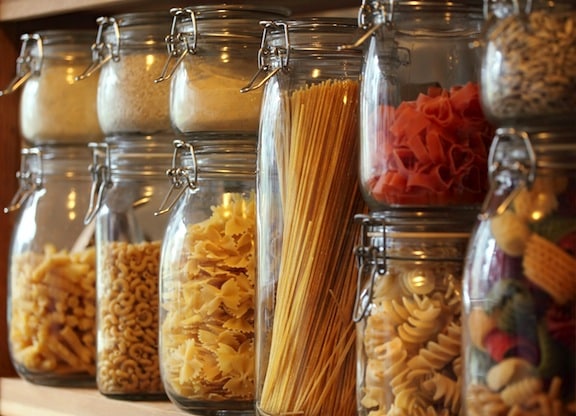
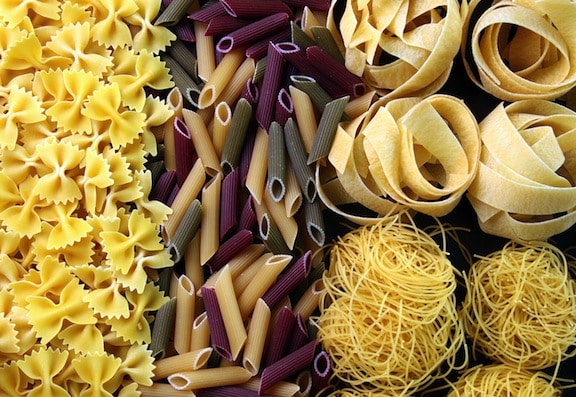
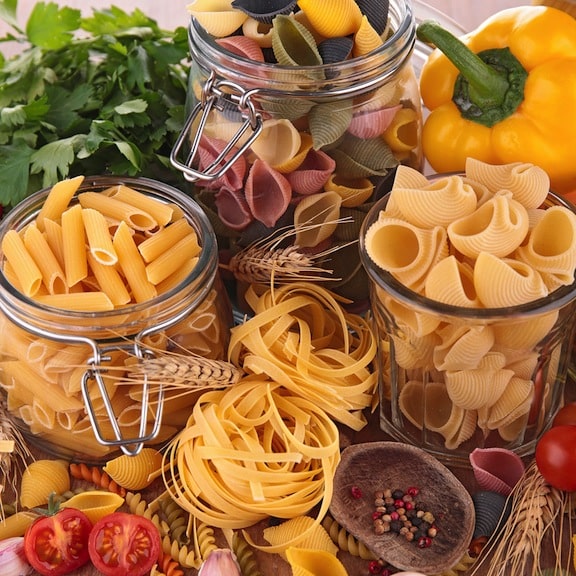
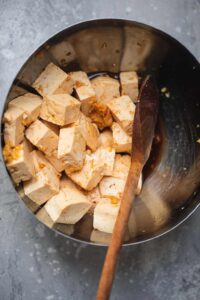

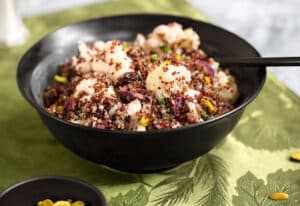
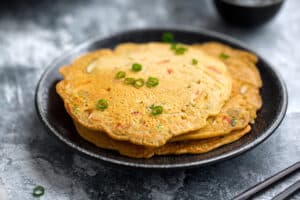
Angel hair Pasta says
Thanks for sharing this great tips & recipes !!
Roman says
I LOVE Pesto!! It's my favourite dip/sauce etc. So much so that I named my first dog Basil and my snoced dog Pesto !! (PS Pesto (the dip not dog!) freezes very well too!)